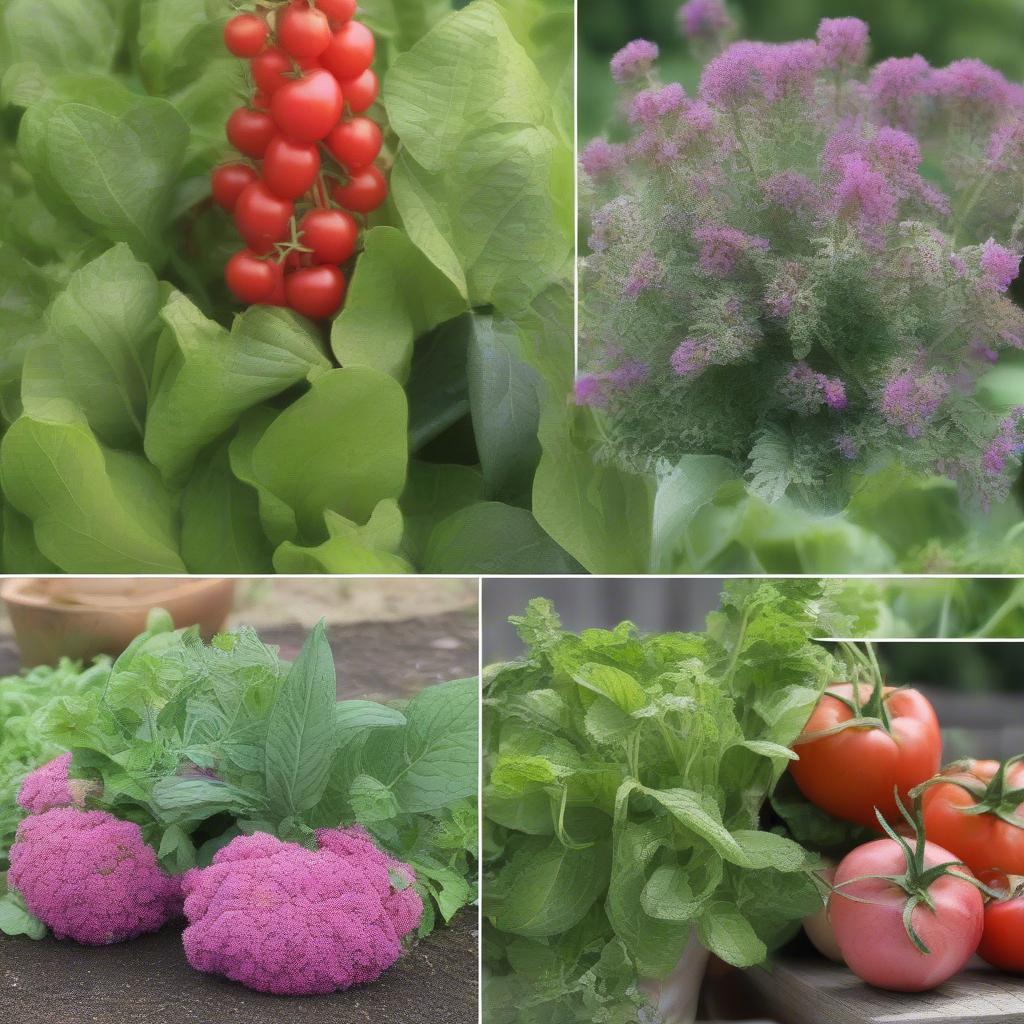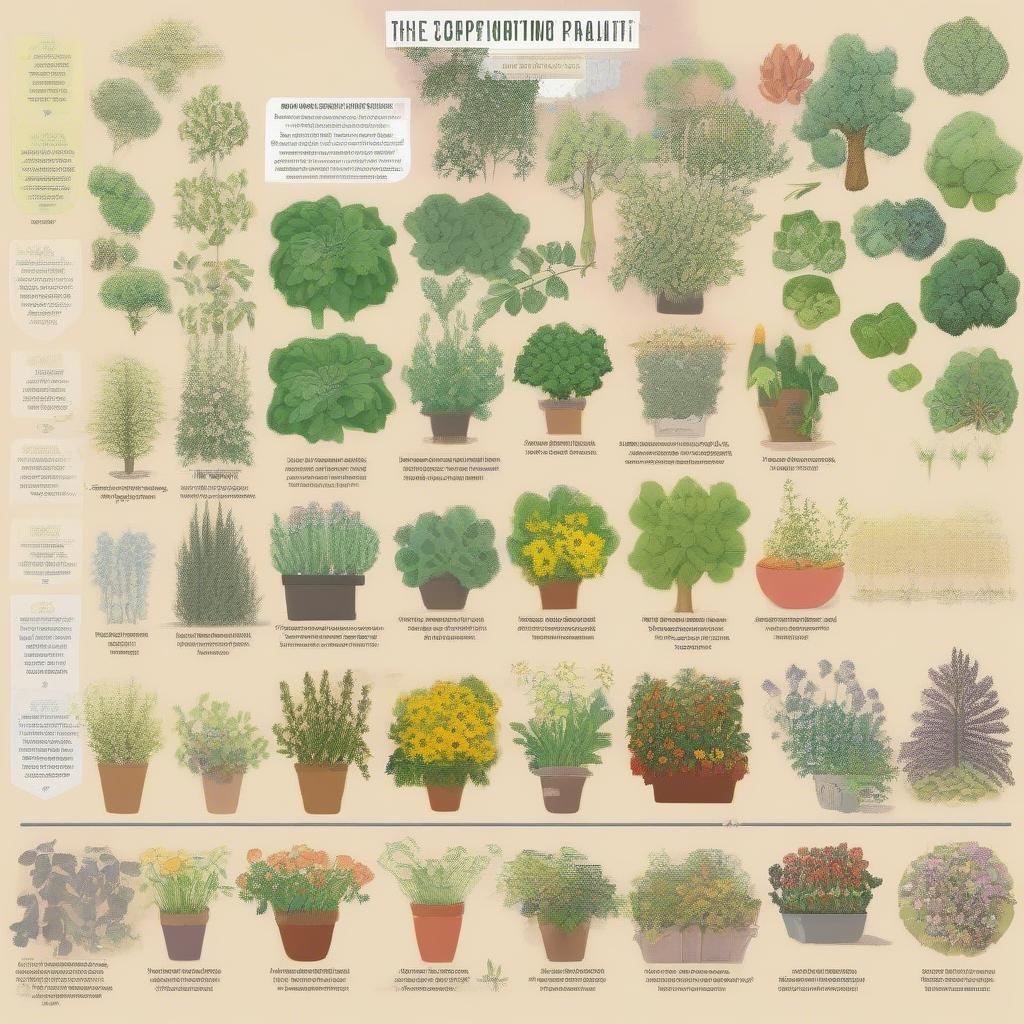
Companion Planting: The Ultimate Guide to Growing Your Best Vegetable Garden
Nadia Hassani, a Penn State Master Gardener, shares her expertise on companion planting, the practice of growing different plants together for mutual benefit. With nearly 20 years of experience in landscaping, garden design, and vegetable and fruit gardening, Nadia provides insights into the benefits of companion planting, the best companion plants, and how to incorporate this technique into your garden.
What is Companion Planting?
Companion planting is the practice of planting different plant species in close proximity so that they can offer identifiable benefits to one another. Sometimes the benefit is onesided, with one plant selflessly offering most of the partnership advantages to the other. In other cases, the benefit is mutual, with each plant enhancing the other’s health or vigor.
Companion Planting Chart
Before you even start thinking about companion planting in your garden, make sure that you follow the rules of crop rotation. Don’t plant the same garden crop in the same spot for consecutive gardening years, as this can lead to pest and disease problems and nutrient imbalances. Depending on the source you consult, information on which plants make good companion plants for each other can vary greatly. Only a few hard facts are unanimously and universally agreed upon. Here is a list of popular garden crops with their anecdotal recommended companion plants:
- Asparagus: Calendula, Petunias, Tomatoes
- Basil: Peppers, Purslane, Tomatoes
- Beans: Broccoli, Cabbage, Carrots, Cauliflower, Corn, Cucumbers, Eggplant, Garden peas, Potatoes, Radishes, Squash, Strawberries, Tomatoes
- Beets: Brassicas, Bush beans, Garlic, Lettuce, Onion-family
- Broccoli: Oregano, other Brassicas (cabbage, Brussels sprouts, cauliflower, etc.)
- Brussels sprouts: Basil, Beans, Beets, Carrots, Garlic, Mint, Nasturtium, Onions, Peas, Thyme
- Cabbage: Other cole crops (broccoli, Brussels sprouts, Collard greens, Kale, Kohlrabi, Rutabagas, Turnips), Onions, Potatoes
- Carrots: Chives, Leeks, Onions, Peas, Radishes, Rosemary, Sage
- Cauliflower: Beans, Beets, Broccoli, Brussels sprouts, Celery, Corn, Onions, Radishes, Spinach
- Cucumber: Beans, Beets, Corn, Onions, Garden peas, Radishes
- Dill: Broccoli, Brussels sprouts, Cabbage, Corn, Cucumbers, Lettuce, Onions
- Eggplant: Beans, Catnip, Marigolds, Peas, Peppers
- Garlic: Beets, Carrots, Cole crops, Eggplant, Peppers, Potatoes, Tomatoes
- Kale: Beets, Beans, Celery, Cucumbers, Dill, Garlic, Lettuce, Mint, Onions, Peas, Peppers, Potatoes, Rosemary, Sage, Spinach
- Lettuce: Corn, Pumpkins, Radishes, Squash
- Onions: Beets, Carrots, Cole crops, Lettuce
- Peas: Beans, Carrots, Corn, Cucumbers, Eggplant, Peppers, Radishes, Spinach, Tomatoes
- Peppers: Basil, Onions, Okra
- Potatoes: Beans, Cole crops, Corn, Lettuce, Spinach, Radishes
- Radishes: Chervil, Lettuce, Nasturtium, Peas
- Rosemary: Beans, Broccoli, Brussels sprouts, Cabbage, Carrots, Cauliflower, Kale
- Spinach: Beans, Cilantro, Eggplant, Oregano, Peas, Rosemary, Strawberries
- Strawberries: Borage, Bush beans, Caraway, Chives, Lettuce, Onions, Sage, Spinach, Squash
- Tomatoes: Basil and other herbs, Carrots, Cucumbers, and Squash as part of a three-way companion partnership, Watermelon and other melons
- Winter squash (including pumpkins): Beans (pole), Buckwheat, Calendula, Corn, Marigolds, Nasturtium, Oregano
- Zucchini and other summer squash: Beans, Corn, Garden peas, Radishes
Benefits of Companion Planting
There are numerous benefits to companion planting. Plants can attract beneficial insects and pollinators, deter pests, and act as insect repellants. They can fend off predators and undesirable wildlife. Raccoons, for instance, dislike the smell of cucumbers. Plants also play a role in soil fertility by improving the nutrient supply, availability, and uptake from the soil. Tall plants such as corn can provide shade for crops like lettuce which do not do well in the hot summer sun, and they can serve as support for crops that need trellising. Interplanting different crops can help mark garden rows and distinguish fast-germinating plants like radishes from slower-germinating plants like lettuce. Proper companion planting can even help suppress weeds.
Tip: It’s best to plant companion plants as close to each other as you can without compromising their usual spacing requirements. Most plant spacing preferences are listed on seed packets and plant care guides. However, not all plants are the same. For example, some might prefer to be 6 inches apart, while others might like a distance of 12 inches. In this case, split the difference – plant them 9 inches apart.
Best Companion Plants
Some vegetable combinations are superstars in bringing out the best in one another or in preventing common pest and disease problems. Among these outstanding combinations:
- Corn, pole beans, and squash: Known as the three sisters, this combination was first developed by American Indian people centuries ago. Corn, with its sturdy stems, provides upright support for climbing beans. For their part, the pole beans fix nitrogen in the soil, providing essential nutrients for all three sisters. And the large leaves of the ground-dwelling squash shade the soil, retain moisture, and block out weeds.
- Cucumbers, sunflowers, and pole beans: The principle here is the same as for the three sisters – the sunflower supports climbing pole beans, while cucumber vines shield the ground.
- Basil and tomatoes: These can be considered best friends in the garden. Basil repels thrips and disrupts the habits of the moths that cause tomato hornworms.
- Sage, with carrots or cabbage: Sage is a proven repellant for carrot flies and cabbage moths.
- Parsley and tomatoes: Parsley attracts beneficial insects that help keep control of damaging insects that prey on tomato plants.
Some plants benefit almost any plant they are paired with – either by repelling damaging insects or attracting beneficial insects that prey on the bad guys. These champions include:
- Nasturtiums: This plant lures hungry caterpillars away from brassicas, including cabbage, broccoli, and kale.
- Mint: This plant’s scent strongly repels aphids, ants, and flea beetles.
- Garlic: This onion relative has a strong scent that is repugnant to aphids, and all repels a variety of mites, moths, and beetles.
- Dill: This plant is known to attract ladybugs, which are voracious eaters of damaging aphids and spider mites.
Companion Planting with Herbs
Not every garden is large enough to grow various crops for companion planting. But that does not mean that you cannot take advantage of herbs numerous benefits, like trapping and repelling pests and attracting pollinators and other beneficial insects to increase the biodiversity in your backyard. From aphids to tomato hornworms, these are just a few of the culinary herbs that can take care of different pests in your garden or attract beneficial insects:
- Basil
- Borage
- Chives
- Cilantro
- Lavender
- Mint
- Oregano
- Rosemary
- Sage
- Thyme
Allow some herbs to bloom because that’s when they become a natural magnet for beneficial insects.
Flowers as Companion Plants
Planting flowers in your vegetable garden does more than create beauty and provide cut flowers. Annuals such as nasturtiums, sunflowers, marigolds, and zinnias, and perennials such as lavender repel pests and attract beneficial insects.
Flowers as a Beacon for Pollinators
Bees and other pollinators help spread pollen, encouraging vegetable plants to grow, reproduce, and produce fruits and vegetables. Pollinators favor zinnias, sweet alyssum, daisies, sunflowers, and cosmos.
Flowers as Deterrent for Problem Pests
Certain flowers, like petunias, repel squash bugs and tomato hornworms – petunias are a great companion for beans, tomatoes, and corn. Meanwhile, marigolds repel cabbage worms. Cabbage worms mainly target cabbage, mustard greens, kale, broccoli, Brussels sprouts, and related vegetables. Ornamental alliums (including edible ones, like onions, scallions, and chives) also deter deer, rabbits, aphids, cabbage looper, carrot flies, and potato beetles.
Which Vegetables Shouldn’t Be Planted Together
Just as there are plants that make good neighbors, there are plenty of opportunities to plant bad neighbors. Generally, plants that compete because of similar nutrient needs, water, space (above-ground growth and below-ground root systems), and sunlight should not be planted next to each other. For example, a fast-growing zucchini or winter squash vine should not be planted next to lettuce – it will overgrow it in no time. Similarly, tomatoes and corn are unsuitable neighbors because they compete for nutrients and water, and the rapidly growing corn casts too much shade on the sun-loving tomatoes.
Crops that are susceptible to the same plant disease, such as blight, should be kept as far as possible from each other to prevent it from spreading. The same applies to pests. Cauliflower, kale, and other cruciferous vegetables all attract aphids, flea beetles, and cabbage loopers – so keep them as much apart as possible, at least at opposite ends of a garden bed.
Some crops can inhibit the growth of other plants. Fennel is often offered as an example of a poor companion plant that should be given its own spot in the garden, far away from all other crops. Beans and members of the allium family (onions, garlic) are equally bad neighbors – as the presence of onions leads to poor germination of the beans.
 What is companion planting?
What is companion planting?
The practice of growing different plant species in close proximity to offer mutual benefits.
How does companion planting benefit your garden?
Plants can attract beneficial insects, deter pests, improve soil fertility, and provide shading and support for each other.
What is the “three sisters” companion planting method?
A method involving corn, pole beans, and squash, where corn provides support for beans, beans fix nitrogen, and squash shades the soil.
Which plants are good companions for tomatoes?
Basil, carrots, cucumbers, and squash are good companions for tomatoes.
What are some herbs that repel pests?
Nasturtiums, mint, garlic, and dill are great at repelling pests like aphids and moths.
How do flowers like marigolds benefit a vegetable garden?
Marigolds repel cabbage worms and attract beneficial insects.
Can onions and garlic be used as companion plants?
Yes, onions and garlic repel many pests and improve soil health when used as companion plants.
What are some vegetables that should not be planted together?
Broccoli and cauliflower, tomatoes and corn, and zucchini and lettuce are examples of vegetables that should not be planted next to each other due to competitive resource usage and pest attraction.
Why should you avoid planting fennel with certain plants?
Fennel can inhibit the growth of many plants and is best given its own spot in the garden.
Which flowers are beneficial for pollination?
Zinnias, sweet alyssum, daisies, sunflowers, and cosmos are good for pollinators.













